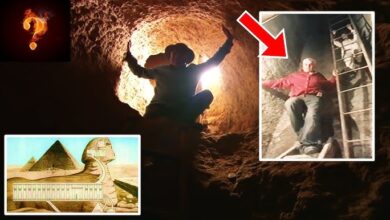What Scientists FOUND Inside Noah’s ARK in Turkey Terrifies The World!
**Shocking Discovery in Türkiye: Have Scientists Found Remains of Noah’s Ark?**

In a remote mountainous region of eastern Türkiye, at the foot of the snow-capped Ararat Mountains, a quiet valley hides a mystery that has intrigued the world. There exists a strange structure shaped like a giant stranded ship, called the **Durupinar Formation** – more than 160 meters long – and has long been believed by many to be the final resting place of the biblical Noah’s Ark.
The story began in the 1950s, when a Turkish military officer accidentally discovered this strange shape from the air. Since then, international film crews such as the BBC and National Geographic photographers began to flock to it, broadcasting images of this terrain to a global audience. And what caught everyone’s eye was that it was very similar in size to the description in the Book of Genesis – nearly 300 cubits long, or more than 150 meters.
For decades, researchers have been exploring this area. One of the pioneers was **Professor Faruk Kaya** from Agri Ibrahim Cecen University. In an interview, he described the feeling when he first set foot on the top of the mysterious mound as “walking on the back of a giant creature buried in mud and time.”
The data collected was surprising: the length, width, and shape of the structure were very close to the description of Noah’s Ark. But what was even more surprising was that soil samples inside the mound had 2–3 times more organic matter and potassium than the surrounding area – a sign that there may have been rotten wood or organic matter inside.
The investigation did not stop there. In 2021, a coalition of scientists from Istanbul Technical University, Andrews University (USA), and Agri Ibrahim Cecen used ground-penetrating radar and electrical resistance scanning technology to peer deep below. What emerged stunned the team: ship-like compartments, a main corridor over 70 meters long, and many “rooms” on both sides – all arranged with right angles rarely seen in nature. Some floors and staircases split into three levels – exactly matching the biblical blueprint.

Beyond the physical shapes, soil samples also revealed traces of marine mud, algae, and even remains of marine life – suggesting that the area was once submerged in seawater – which fits the hypothesis of an ancient flood.
“What we found beneath the rocks and soil is unlike anything natural,” Professor Andrew Jones, one of the project’s leaders, told Fox News. “It all points to the possibility of a man-made structure, with a clear structure, and most notably, it was made of wood.”
Even more remarkable, software that processes the radar data has allowed the team to filter out the mud that covers it, revealing the symmetrical “hull” shape, with rib-like curves – still intact after thousands of years of burial.
While scientists are divided – some believe it is a natural geological phenomenon – the data on the size, shape, soil composition and archaeological evidence are forcing researchers to reconsider what was once considered a myth.
With a series of non-invasive excavations and surveys planned, the team believes this is just the beginning. “We are facing a great mystery, and we have a responsibility to uncover the truth,” said William Crabtree, a soil analyst on the team.
As the sun set behind Mount Ararat, the scientists packed up their equipment, taking with them not only data but also excitement and anticipation. Because right beneath their feet – perhaps – was one of humanity’s oldest stories, written not in words, but in rocks and chemicals left behind by millennia.
“The high potassium content and low pH in the soil samples suggest a long process of organic decomposition – consistent with the hypothesis that there was once a large wooden structure beneath the soil,” Professor Faruk Kaya, a senior geologist, told *The Jerusalem Post. The pH readings provided further evidence: while the surrounding soil was neutral, the area examined was unusually acidic – a hallmark of organic decomposition over centuries.
*National Geographic* described: “Chemical analysis of the Durupinar site reveals a chemical signature rarely seen in nature – indicating the presence of ancient organic material.” As the data poured in, the sense of discovery grew stronger. *Science Channel’s* Forbidden History team, filming at the scene, captured the startling moment when the researchers realized what they were dealing with: “The chemical signatures in the soil are a new layer of evidence, strongly supporting the hypothesis that this was once the site of a giant wooden ship.”
Everything—from the numbers, to the chemical signatures, to the geological structure itself—points to an inescapable conclusion: there was something here, something made of wood and life, now reduced to dust but still leaving an indelible mark.
William Crabtree, a soil scientist on the team, was almost recovered as he held the test results in his hands. “The chemical composition of the soil sample is unlike anything ever seen in natural formations,” he told *Hurriyet*. “The organic matter and potassium content clearly indicates the presence of decomposed wood.” For him and his colleagues, these numbers are more than just data – they are a story written in the language of elements and molecules, telling of something extraordinary that once existed here.








